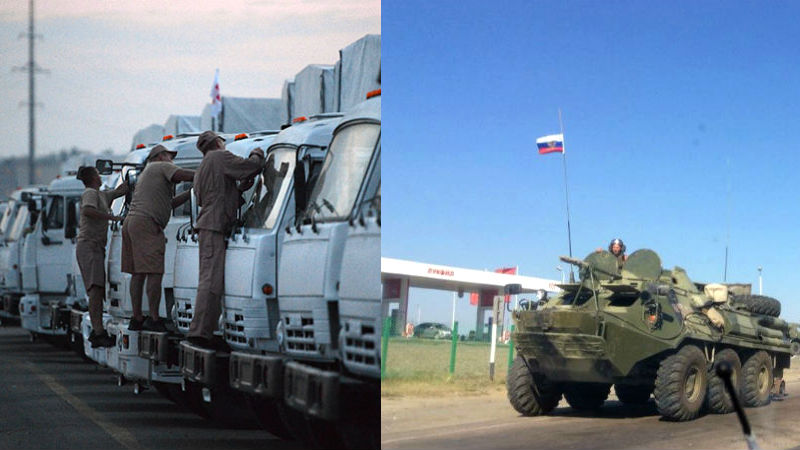
As the humanitarian convoy lingers on the border, Russian APCs roll into Ukraine. Images mixed by author.
As speculation swirls around the huge Russian humanitarian convoy [1] traveling into Eastern Ukraine, Western journalists following the procession of white-washed trucks have witnessed a column of armored vehicles crossing the border from Russia into Ukraine. Could this supposed invasion be the start of something big? And what is happening to the mystery convoy?
Ukraine has claimed before that Russian military transport (APCs, tanks and other vehicles) enters Ukraine regularly through border points controlled by the separatist rebels. But this was the first time several Western journalists, including British and US reporters, witnessed the trespassing first-hand. Shaun Walker [2] of The Guardian tweeted [3] the incident live:
So @RolandOliphant [4] and I just saw a column of APCs and vehicles with official Russian military plates cross border into Ukraine.
— Shaun Walker (@shaunwalker7) August 14, 2014 [3]
Erm ok so this isn't humanitarian aid. Column of over 20 APCs, 10km from the Ukraine border, and heading closer pic.twitter.com/OMvJmHzsx1 [5]
— Shaun Walker (@shaunwalker7) August 14, 2014 [6]
The Telegraph's Roland Oliphant [7] supported Walker's claims and posted a photo [8] as well:
These guys. Lots of them. pic.twitter.com/XM1QCCpmNQ [9]
— Roland Oliphant (@RolandOliphant) August 15, 2014 [8]
The testimony of independent media proved to be a big deal with the international observers. NATO, for instance, said there was evidence to claim there had been a Russian incursion into Ukraine [10], although they did not call it an “invasion” outright. Britain and France have summoned Russian envoys in their countries to demand an explanation of the incident and accused the Kremlin of escalating the fighting.
Ukraine later announced [11] its armed forces had partly destroyed a Russian armored column that entered its territory overnight. The Russian government in response denied [12] that any Russian forces had ceased into Ukraine, and instead said the Ukrainian side was trying to sabotage the delivery of humanitarian aid from Russia to the troubled areas of Ukraine's east.
The embattled humanitarian convoy, meanwhile, remains stuck on the Russian side of the border, as the Russian side claims they're ever closer to moving it into the East of Ukraine. Ukraine and the International Committee of the Red Cross, meanwhile, insist Russia provide them with a detailed list of the contents of the trucks. As of this morning, the column of 280 aid vehicles was parked near the town of Kamensk-Shakhtinsky in Rostov region, where experts from the ICRC and the Ukrainian customs officials were arriving to figure out how they could start checking the cargo. Ideally, once the trucks’ contents were examined by the ICRC and the paperwork processed by the Ukrainian customs, the humanitarian aid would come under the control of the Red Cross and be moved into Ukraine.
Earlier, Russian and international media got to peek inside some of the trucks and saw bags of buckwheat, baby food, sleeping bags, portable generators and water. Some of the correspondents, like Financial Times’ Courtney Weaver [13], noticed [14] that quite a few of the trucks were less that half full and wondered why that was the case.
Got to check out more convoy trucks this morning. A lot of them mostly empty like this one pic.twitter.com/9qM7bYliv9 [15]
— Courtney Weaver (@courtneymoscow) August 15, 2014 [14]
This was corroborated by other journalists, including Slon.ru's own reporter [16] at the scene, and caused a wave of suspicion online. Alec Luhn [17], another reporter covering Russia, speculated [18] that humanitarian aid was a pretext for the trucks to come into Ukraine, and they were really there to carry fighters and arms back to Russia:
So Russia's aid convoy is half empty. Maybe this is not so much about taking in aid as taking out rebels & arms? pic.twitter.com/w4AzMC2p01 [19]
— Alec Luhn (@ASLuhn) August 15, 2014 [18]
A Russian emergency ministry representative explained to reporters that the vehicles were not full because otherwise the trucks would be overloaded and wouldn't be able to carry so much weight. The truck drivers themselves were skeptical of this explanation, says Slon.ru, but did not deign to provide their own version.
As Ukraine and Russia accuse each other of undermining the humanitarian mission, and the West wonders if they have just witnessed the start of open Russian aggression against Ukraine, the presence of independent journalists on the scene at the border gains importance. While the white trucks of the humanitarian convoy stand still, there's quite a lot of other movement there: blink, and another armored vehicle has whizzed by. Yuri Maloverjan [20], a BBC Russian Service correspondent, saw two groups of Russian military transport near the Russian bordertown of Donetsk within one hour:
В сторону укр.границы пошла колонна машин в 40 без номеров. И БТР. #Донецк [21] pic.twitter.com/WuI3XpKf21 [22]
— Jüri Maloverjan (@MaloverjanBBC) August 15, 2014 [23]
A column of about 40 cars, with no license plates, went to the Ukrainian border. And an APC. #Donetsk
Пока писал предыд.твит, мимо к границе Украины прокатилась ещё колонна: 30 единиц, в т.ч. 10 БТРов.
— Jüri Maloverjan (@MaloverjanBBC) August 15, 2014 [24]
While I was typing the previous tweet, another column passed by me on its way to Ukraine: 30 units, including 10 APCs.
While citizen journalists posting photos and videos of the military transport moving around and near Ukraine [25] have been instrumental in untangling conspiracies about Russia's role in supporting the rebels, the reports of international journalists on the scene will likely be crucial in providing the international community with more solid evidence. This could allow the West to make a convincing case against Russian aggression—or give Russia the means to disprove it.